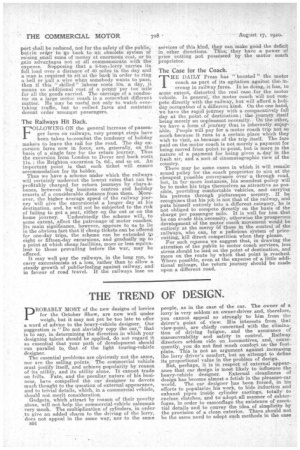THE TREND OF DESIGN.
Page 2

Page 3

If you've noticed an error in this article please click here to report it so we can fix it.
pROBABLY MOST of the new designs of lorries for the October Show, are now well under weigh, but it may not yet be too late to offer a word of advice to the heavy-vehicle designer. Our suggestion is "Do not slavishly copy the car," that is to say, in determining the direction in which your designing talent should be applied, do not regard it as essential that your path of development should run parallel to that of the light touring-vehicle designer.
The essential problems are obviously not the same, nor are the selling points. The commercial vehicle must justify itself, and achieve popularity by reason of its utility, and its utility alone. It cannot trade on frills. Fate, and the• peculiar nature of his business, have compelled the car designer to devote much thought to the question of external appearance, and to trivial details, which, in a commercial vehicle, should not merit consideration.
Gadgets, which attract by reason of their novelty alone, will not help the commercial-vehicle salesman very much. The multiplication of cylinders, in order to give an added charm to the driving of the lorry, does not appeal in the same way, nor to the same n24
people, as in the case of the car. The owner of a lorry is very seldom an owner-driver and, therefore, you cannot appeal BO strongly, to him from the driver's point of view. His interests from that view-point, are chiefly concerned with the elimination of driving fatigue, and the assurance of maneeuvrability and safety in control. Railway directors seldom ride on locomotives, and, consequently, you do not find much comfort on the footplate. This is not an argument against increasing the lorry driver's comfort, but an attempt to define its proportional value in the problem of design..
But, perhaps, it is in respect of external appearance that car design is most likely to influence the heavy-vehicle designer. External cleanliness of design has become almost a fetish in the pleasure-car world. The car designer has been forced, in his efforts to popularize his work, to hide induction and exhaust pipes inside cylinder castings, totally to enclose clutches, and to adopt. all manner of subterfuges, in order to camouflage the existence of essential details and to convey the idea of simplicity, by the provision of a clean exterior. There should not be the same need to adopt such methods in the case of the heavy vehicle. Not that cleanliness is not
a virtue in design ; so long as dusty reads are in existence, it is, undoubtedly; but, again, as in the case of driving comfort, its relative importance in the scheme of things requires adjustment. What use has the lorry.user for it, excepting in so far as it protects susceptible mechanism from damage, or makes for economy either in manufacture or in operation 1 It is not otherwise of much importance. The greatest argument against external cleanliness in design is that, often in its pursuit, the designer is tempted to introduce a measure of inaccessibility. There are, we are aware, arguments against the too ready accessibility of many parts., The magneto is often cited as an example. "If you make your mechanism reliable enough, if you perfect your machine, it should not fail," some people say. Having iperfeeted it then, why not protect it from the inexpert attention of ignorant and inexperienced meddlers? That argument is sound enough, perhaps, when you are certain tha-t your mechanism is infallible, Who is?
But there are two aspects of accessibility : There is accessibility in operation, and there is accessibility in overhauling and rap air. In these days of high labour costs, the last mentioned is not the least important. No One can afford to waste unnecessary time in " getting at things," in order to examine them, even though they do not actually require
attention. Therefore the sacrifice of accessibility to external appearance and cleanliness is questionable practice. It is, indeed, highly important that more attention should he devoted by designers to the effect of inaccessibility on repair-costs.
There is another point: The lorry owner often executes his own repairs in his own workshop, and soaring costs for overhaul are quickly noticed. If it is fonud that inaccessibility'amts them up, so much the worse for his opinion of the design. With the car owner it is different. Extensive 'repairs are generally beyond his capabilities, and they ate executed in a garage, over which he has no jurisdiya don, and where he can have little insight into the mysteries of costs. , :Here is an essential and important difference, wnich the heavy-vehicie designer should not overlook.
In making the foregoing remarks, we have in mind the load carrying, and not, the heavy passenger type of vehicle.
It seems likely that, from now enwards, the paths cif the heavy vehicle designer will diverge in two distinct directions, the one leading towards the perfection, of the load-carrying chassis, and the other towards the evolution of lighter, high speed passenger-carrying vehicles. Towards the perfection of the latter, the example of light passenger car design should contribute a great deal.
If we exceptP,the bus, the chassis of the presentday char-à-banes was primarily designed for carrying
goods--not people— It is thus obvious that it cannot
lae,,ideal for both purposes. Whilst no very widespread demand existed for mad; travel of. this
description—naaas, 'motoring as it is sometimes called—it was unreasonable to expect designers to provide special char-a-bancs chassis. But, now the demand has been shown unmistakably to exist, they will have to beiproducecl and, in this branclaof heavy vehicle design, the influence of, the so-called "pleasure " car will, undoubtedly, be seen. But, even so, there will still be little need, or room, for fads and frills. The market conditions are entirely different.




























